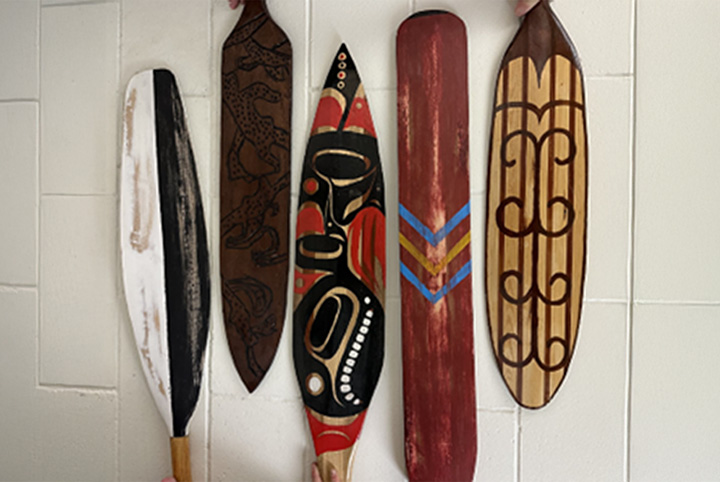
How can we bridge traditional Indigenous technologies with current innovations in woodworking?
In a Grades 9 to 12 woodworking class, learners explored, through a design project, Indigenous development of technology and how it affects production and society. The essential guiding question was, “Are there Indigenous technologies that are adopted in our society?”
In small groups, learners discussed the concept of technology, what drives its development, how it changes, how long it lasts, and the effects it has in their daily lives. Afterwards, learners were asked what they knew about Indigenous technologies. What technologies have proven to be effective and efficient throughout human history that are still used today? Learners contributed their ideas to an open Google Doc shared among the class. They then analyzed views and perspectives from all learners to open questioning and to challenge assumptions and persisting values.
To help deepen learner understanding, the teacher asked, “How do we know about historical technology and people’s history?” The teacher then explained the difference between primary and secondary sources of information so that learners could look critically at the sources they were investigating. When looking at sources, learners practised recognizing how diverse perspectives and contexts could affect and influence their thinking.
Learners then reviewed the article “The History of Paddle Design and How to Carve One” by Beth Stanley (online) from Canadian Woodworking and Home Improvement. Another useful resource is Indigenous Skills: An Exploration of Northwest Coast Carving and Tradition by the Construction Foundation of British Columbia—particularly the paddle information on pages 28 and 29. In groups, learners researched Indigenous paddles and watercraft from various regions of Canada and locations all over the globe. They considered historical, sport, recreation, and utility perspectives, and examined how different perspectives were rooted in context. They also examined how changes in paddle design and construction were made to match unique needs and uses, such as ceremonies, warfare, river, lake, stand-up paddleboard (SUP), or sailing paddles. The learners discovered that paddle and watercraft technology was perfected by Indigenous groups all over the world and has persisted as the gold standard of design for thousands of years.
The Canadian Canoe Museum is an online source that learners looked at to explore the archival record of paddles and watercraft in Canada. They captured images of primary sources, such as original paintings made in the late 1700s showing Indigenous groups, their watercraft, and paddles, as well as photos of actual archival paddles from the collection. They documented what they learned from this source and then prepared questions for a virtual field trip to the Canadian Canoe Museum, which dedicated 50 minutes to different paddle examples from Indigenous groups in Canada. Learners interacted with the guide, asked questions about design, and used their learning to help them determine a design direction for their own paddles. At the conclusion of this research phase, learners shared their learning to deepen each other’s understanding in a round-table format and chose a paddle from an international or local Indigenous group to recreate as an exemplar.
The next phase of the learning experience was to practise with the various tools in the shop that would be used for the paddle construction. Learners were challenged to use both hand and power tools (such as drawknife versus hand planer versus power planer) for this project. The teacher introduced the learners to modern technologies such as waterproof adhesives, epoxy, and composite laminates.
Learners then began the design process for their own paddles. They drafted a technical design plan for their paddle based on their previous learning, and they included drawings, dimensions, tools, processes, and special features. Learners chose what tools, methods, and materials they would use for their build based on all of the information they had gathered throughout the research process, which ultimately informed their decision-making. They used a criteria checklist to ask for feedback on their designs from their peers and adjusted their plans, as necessary.
Once the plan was complete and reviewed, learners spent classes building their paddles. Those with more experience were challenged to include techniques such as steam bending, more complex laminations, and composite layering into their builds. Each learner also spent one period working on a class paddle, hand-carved using traditional tools such as a crooked knife and an adz from a solid blank, as was done historically. Learners aimed to recreate the shape, markings, and decorations on their historical paddles.
As a final experience, learners brought their completed paddles to the lakeshore. The class stood in a circle and each paddle story was presented to the group. Learners explained the history and cultural significance of the design and how it had an impact on the Indigenous group that used it. They also shared their experience of building the paddle, and how their skills and attitudes changed when using several types of tools and technology. These reflections were recorded and uploaded to the Google Classroom where learners later used them to draft a museum-style information plaque for each paddle. They considered how this new audience, purpose, and form would be different for the museum-style plaque and revised their ideas to meet these different elements.
The plaques were then created in V-Carve software and cut on the CNC router. To celebrate and share their learning with a broader audience, the paddles and plaques were displayed in the school for the remainder of the year before going home with the learners.
Canadian Canoe Museum. “Virtual Field Trip of the Canadian Canoe Museum.” Virtual Tours, 2024.
Construction Foundation of British Columbia (CFBC). Indigenous Skills: An Exploration of Northwest Coast Carving and Tradition. 2021.
Murat. “Cree Paddles.” Paddle Making (and Other Canoe Stuff), Blogspot, January 20, 2009.
———. “Indigenous Paddling Techniques.” Paddle Making (and Other Canoe Stuff), Blogspot, August 2, 2012.
Stanley, Beth. “The History of Paddle Design and How to Carve One.” Canadian Woodworking and Home Improvement, June/July 2011.